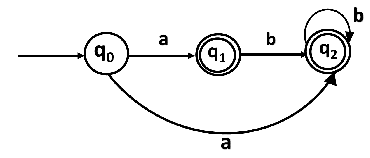Epsilon NFA (∈-NFA)
- In the state diagrams, they are usually labeled with the Greek letter ∈ also called lamda.
- ∈-transitions provide a convenient way of modeling the systems
- Due to empty move, the first string of language may be a empty or epsilon.
Formal Definition of Epsilon-NFA
The formal definition of ∈-NFA is represented through 5-tuple (Q, ∑, δ, q0, F) where,
- Q is a finite set of all states (q0, q1, q2, … qn) where n is finite number
- ∑ is a finite set of symbols called the alphabet. i.e. {0, 1},
- δ : Q x (∑ U ∈) → 2Q is a total function called as transition function
- q0 is the initial state from where any input is processed (q0 ∈ Q).
- F is a set of final state/states where F will be subset ( ⊆ ) of Q.
Eliminating ε Transitions
NFA with ε can be converted to NFA without ε, and this NFA without ε can be converted to DFA. To do this, we will use a method, which can remove all the ε transition from given NFA. The method will be:
- Find out all the ε transitions from each state from Q. That will be called as ε-closure{q1} where qi ∈ Q.
- Then δ' transitions can be obtained. The δ' transitions mean a ε-closure on δ moves.
- Repeat Step-2 for each input symbol and each state of given NFA.
- Using the resultant states, the transition table for equivalent NFA without ε can be built.
Example:
Convert the following NFA with ε to NFA without ε.

Solutions: We will first obtain ε-closures of q0, q1 and q2 as follows:
ε-closure(q0) = {q0}
ε-closure(q1) = {q1, q2}
ε-closure(q2) = {q2}
Now the δ' transition on each input symbol is obtained as:
δ'(q0, a) = ε-closure(δ(δ^(q0, ε),a))
= ε-closure(δ(ε-closure(q0),a))
= ε-closure(δ(q0, a))
= ε-closure(q1)
= {q1, q2}
(q0, b) = ε-closure(δ(δ^(q0, ε),b))
= ε-closure(δ(ε-closure(q0),b))
= ε-closure(δ(q0, b))
= Ф
δ'(q1, a) = ε-closure(δ(δ^(q1, ε),a))
= ε-closure(δ(ε-closure(q1),a))
= ε-closure(δ(q1, q2), a)
= ε-closure(δ(q1, a) ∪ δ(q2, a))
= ε-closure(Ф ∪ Ф)
= Ф
δ'(q1, b) = ε-closure(δ(δ^(q1, ε),b))
= ε-closure(δ(ε-closure(q1),b))
= ε-closure(δ(q1, q2), b)
= ε-closure(δ(q1, b) ∪ δ(q2, b))
= ε-closure(Ф ∪ q2)
= {q2}
The δ' transition on q2 is obtained as:
δ'(q2, a) = ε-closure(δ(δ^(q2, ε),a))
= ε-closure(δ(ε-closure(q2),a))
= ε-closure(δ(q2, a))
= ε-closure(Ф)
= Ф
δ'(q2, b) = ε-closure(δ(δ^(q2, ε),b))
= ε-closure(δ(ε-closure(q2),b))
= ε-closure(δ(q2, b))
= ε-closure(q2)
= {q2}
Now we will summarize all the computed δ' transitions:
δ'(q0, a) = {q0, q1}
δ'(q0, b) = Ф
δ'(q1, a) = Ф
δ'(q1, b) = {q2}
δ'(q2, a) = Ф
δ'(q2, b) = {q2}
The transition table can be:
|
States |
a |
b |
|
→q0 |
{q1, q2} |
Ф |
|
*q1 |
Ф |
{q2} |
|
*q2 |
Ф |
{q2} |

State q1 and q2 become the final state as ε-closure of q1 and q2 contain the final state q2. The NFA can be shown by the following transition diagram:





No comments:
Post a Comment